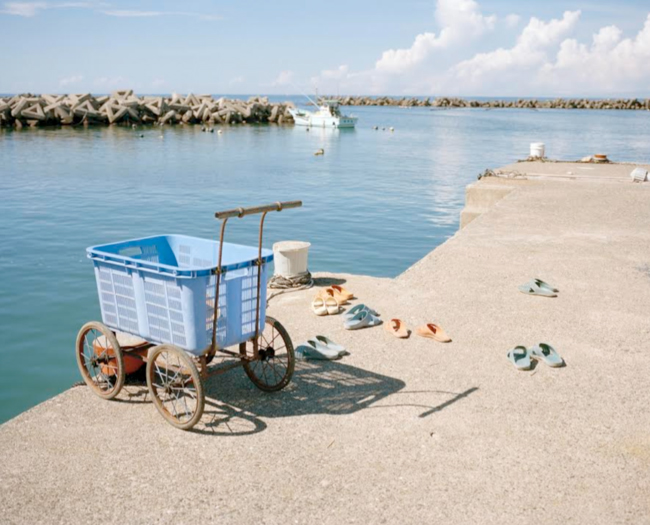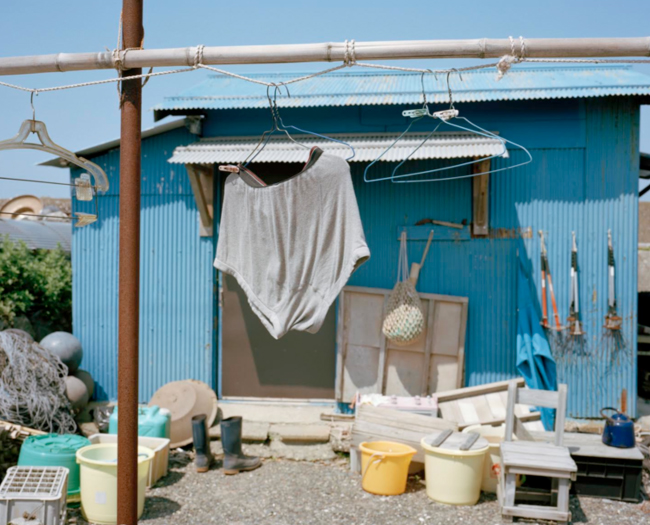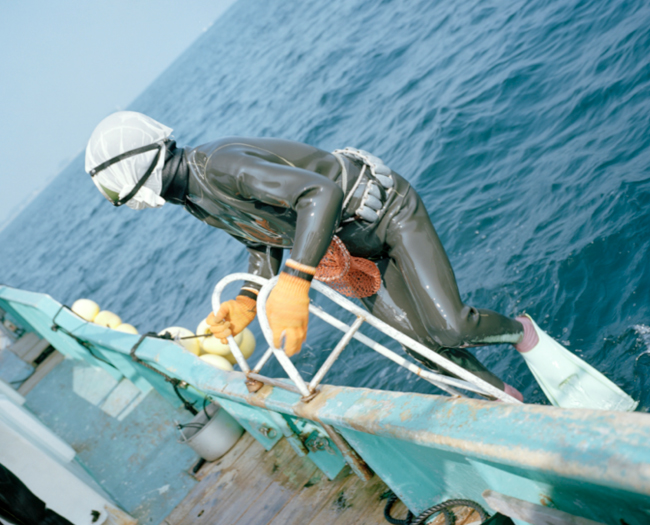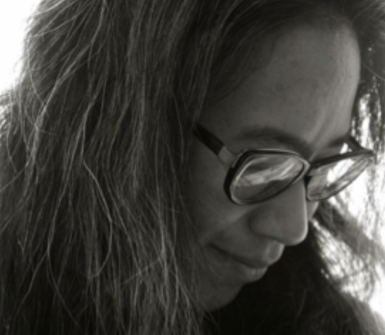On almost every day of her long life, Sumiko Iseya (née Nagata, 1954-2040) jumped into the Pacific Ocean and dove through shadows blue-on-blue to frigid depths of perhaps 30 meters. She was an ama (ocean-woman), predator-daughter-mother of the deep. Not for her any scuba, snuba, snorkel. Sumiko learned to dive from her foremothers, learned to breathe from whales. Down to the seafloor, reef, kelp forest, where she stayed for 2 minutes, ascending with laden hands, breaking the surface with a gasp like a cry of pain — exhaled in a long whistle which some called the sea’s lament (iso nageki). She deposited her load in a floating wooden barrel and dove again: 50 dives an hour.
She was after snails: sazae with silver shells like inverted whirlpools and their sisters, awabi, mother-of-pearl abalone with expressive eyes. She also hunted their cousins, octopi, urchins, spiny lobsters, sea stars, seaweeds, and sea cucumbers (namako). But awabi were above all: noshi awabi was the sacred sustenance of the divine kami. Amaterasu, ancestress of all Japan, and luxury markets paid ¥8000 per pound of awabi sashimi.
Even men followed awabi into the water when prawns were scarce or finned fishes weren’t biting. Men preferred fishing from boats atop the sunlit surface. Grubbing in the sand in all the perilous betweens, between light and dark, air and water, life and death; turning over rocks and plunging hands into black crevices, the secret lairs of biting eels and stinging puffer fish; battling the cold, the currents, struggling mollusks, and the fighting urge to breathe — that was women’s work. When Sumiko was born, no community incurred greater disdain than the ama. They were hinnin, strangers who dirtied themselves with death’s dirty work. But from her mother and grandmother, Sumiko inherited the belief that all ama shared. It wasn’t that women and snail-seeking were ignoble.
They believed that only women had enough subcutaneous fat to endure cold at extreme depths. They believed that women needn’t fear the ocean’s chilling love. And ama couldn’t be afraid. Sumiko feared only one thing. Not running out of air, not sharks, demons, freak currents. She was optimistic, curious, and proud, with indefatigableness she inherited from her ocean-mother. She lived half a century before tasting fear for the first time: fear of being unable to lie to her daughters.
Daughters, she believed, are those to whom you give existence, shape, mass, energy, and a place in the world. Daughters devour, exult, and endure. Mothers make and give, position, suffer, and rejoice. Because Sumiko was of the ocean — where all was slippery, shadowed, roving, waving — she believed in the fluid simultaneity and ceaseless blending of visible and invisible life. She believed that mothers’ acts and memories carved their daughters’ bodies and believed that daughters should also be mothers. The ocean was Sumiko’s mother-daughter. Awabi were her daughters and her mothers. Ama followed the awabi as they followed their human mothers into the ocean, devoured the sea-snails as they fed on their mothers’ milk.
#
Her great-great-grandmother learned to dive from her mother, who learned from her foremothers. She taught her daughters, and her daughters taught their daughters. She was a migrant following awabi along the southern coast. As the Edo period waned, she and her daughters slipped between fiefdoms in a wooden boat.
Her husband steadied the boat while they submerged. He looked into the clear water, watching over them, sometimes used a rope or bamboo pole to whisk them through the final sun-splashed meters of their ascent.
They obeyed him in all things but one. His wife told him where to steer the boat. The household moved with her sense of the ocean. Her earnings were sizable, for there were fewer funado ama deep-diving from boats than there were kachido ama swimming out from shore to work the shallower waters.

They sold their snails to whichever shoreline village had charge of the water in which they dove. Villages welcomed them, sometimes giving them land in addition to fishing rights, for every village owed a certain amount of noshi awabi to its feudal lord, who took it to the Shinto shrines and gave it to the kami.
Sumiko’s grandmother told stories of noblefolk who envied her great-great-grandmother.
She was always chasing discoveries, Sumiko said of her great-great-grandmother, free to be a loudmouth and a dirty one at that. Highborn women had to be quiet and sweet and agree with the men in everything. And they were often afraid. There was always some backstabbing intrigue going on in their big houses.
Fisherfolk had simpler lives. We retained the kind of humanity that fancy people forgot when they got lost in all that power and silk — the kind that comes from nature.
But that’s how it was then. Nowadays, everything’s different. Everything hangs by a thread. And we’re the ones getting lost.
Sumiko’s mother and grandmother taught her to dive as her great-great-grandmother dived: naked except for a bandanna with protective symbols, a loincloth and mulberry rope around her waist. The rope tied her to a boat, netted float, or floating barrel, depending on her prey. It secured her nomi to her back: the wooden spatula she used to wrestle snails from rocks. She carried a net bag with a pointedly wide mesh — wide enough to give awabi every chance to tumble to freedom.
#
Sumiko’s grandmother resisted the diving mask. It would make them see too well, she said, they’d discover and kill too many hidden snails. It magnified everything — made her fearful of kidnapping babies. All the ama said:
10.6 centimeters. A smidgen smaller — use a ruler — and you have to release them. Find somewhere dark and narrow with kelp nearby. Give awabi babies every chance.
Sumiko’s grandmother balked at the wetsuit too. Disrespectful, said Sumiko’s grandmother, to go to the ocean like that. You don’t see whales going around like that. Like demons, umi bōzu — glossy, black, humanoid giants who thrashed the sea into deadly typhoons. Plus, you’re more likely to snag something and get stuck. Then you’d drown. Wouldn’t happen if you dressed the way your mother made you.
Yet it was Sumiko’s grandmother — while her daughter-in-law, Sumiko’s mother, roared with laughter — who was the first Nagata ama to wear clothes into the water. Skirt and blouse, pearl-white, they’d go down in history as the “traditional” costume of Japanese ama. These outfits, amagi, offered little warmth, flailed in the water, and were designed in the twentieth century by the Mikimoto Pearl Company in Toba.
World Wars brought an end to migrant work. In each village, a sea tenure system enforced by a local co-op granted fishing rights only to residents. Sumiko’s village, Kaiyono, was a ward of Toba. Her grandmother worked part-time for the pioneer of cultured pearls, diving up oysters, taking them back down after someone in the factory slipped tiny irritants into their shells. The pearls were world-famous, as were Mikimoto’s ama. But the sight of their thick, brown, naked bodies appalled the factory’s non-Japanese visitors.
Sumiko was a senior citizen when she got her first amagi, handmade by a friend in the ama Preservation Association. She never dived in it, only wore it to her night job. Neither she nor her mother, her great-great-grandmother, nor any of their friends ever hunted pearls. But she said “traditional” without a whiff of sneering.
As a child, she asked, Doesn’t it hurt them, ripping them open? Shoving rocks down their throats?
This made her grandmother feel like a sapling in an earthquake. At the factory, they said they were helping oysters: oyster farming for cultured pearls helped the oyster population to recover from previous generations’ over-harvesting. Maybe they were right, but so was Sumiko. Torturing oysters was no better than killing them.
Sumiko didn’t know it, but this was her first exposure to the feeling that drove every ama to frustration — the sense that their efforts to conserve were all for nothing.
#
The co-op allowed each household one wetsuit. Sumiko’s mother claimed it, a skillful funado who breastfed Sumiko on the beach between dives. Reminiscing, she said:
We were already diving five, six hours every day. If all of us stayed even longer, toasty warm in our wetsuits, think how many more awabi would’ve died.
Sumiko had no opportunity to wriggle into a wetsuit till she was almost thirty. Growing up, she dove in cotton shorts and a bandanna, imitating her mother’s straight-down dive, feet skyward shooting. Her mother taught her, as she’d learned from her mother, to live and dive and die in the current that commingled predators and prey and daughter-mothers as it swirled and surged and flagged and swirled up again in time. Best day of my life, Sumiko would say, when she walked into the ocean with her mother and grandmother for the first time, a young teen with her own nomi, mask, and barrel.
They walked without mincing though waves towered over them. They laughed when the ocean slapped them in the face with the full force of its grandeur, 3 generations with their faces to the blue-on-blue. Sumiko recalled:
Back then, I could catch 40 awabi a day. 10 years ago, I was down to 4 a day. Nowadays, if you can find one, that’s really something.
With chattering teeth, red eyes, and heavy barrels, the ama emerged from the water and huddled, ten or twelve to a group, shuddering, kimono-swaddled, around a small pit fire in the amagoya, their narrow bamboo hut. Later goya were of corrugated tin sheets held down by rocks. They had showers and places to hang nets and floats, drying wetsuits, sodden underwear. Some even had doors, which the ama left open to keep an eye on the ocean. Though they sneaked emulous looks at other people’s catches, they’d run back to the sea if anyone came into difficulty. Sumiko said:
The best thing about being an ama is the ocean. Second best: the snails. Third: the amagoya. That’s our real home.
It was a noisy place. Wood cracking, wetsuits flapping, water hissing on the fire. Loud gossip, singing, shouting fisherfolk tales (“The Big One” “The One That Got Away”), boasting and bitterness about the size of the haul and the best and worst divers, bawdy jokes about husbands and who had better breasts.

Outsiders thought the ama the opposite of beautiful. They were too brown from the sun, too stocky with necessary fat and muscle, coarse of hand and tongue, dirty with sand and slaughtered sea-snail slime, slithering in in-betweens. But their almost inhuman strangeness, the sense that their dolphin-esque ability was some kind of mutation, and the bareness that shocked Mikimoto’s clientele lured anthropologists, physiologists, and photographers to Kaiyono. Salarymen followed, seeking the slender, white-clad pearl-divers and topless amazons they’d seen in advertisements and a James Bond blockbuster. The demand for awabi sashimi shot up, hotels shot up and dumped sewage in the ocean.
Sumiko didn’t feel like a sex symbol. She strained under the weight of barrels full of squirming snails, hustling them to the co-op for weighing. She bent double under piles of seaweed she bore on her back from boat to shore. She helped her father drag in the great prawn-fishing nets, which the ama had to clean, picking out dead fish and garbage. Everyone threw their weight against the boats’, heaving them onto the beach, hauling them into the hills out of the weather, dragging them back down again in the morning. When all ocean-work was done, there was still the house to clean, vegetables to tend. And Sumiko could not complain, couldn’t carry less than the maximum that she could manage, fail to take risks in the water, seem to tire easily, come up to breathe too often, surface empty-handed. Fishermen and other ama would publicly remark upon that kind of thing. And yet, her mother said:
The most important thing to do in diving is relax!

With her kachido and funado skills, Sumiko’s parents kept her around as long as possible. But Sumiko couldn’t wait to get married. Not that there was anything spectacular about Hideki Iseya, the Kaiyono-born fisherman selected by her father. What Sumiko really wanted was a daughter.
She’d already amassed a hoard of Things To Tell Her. She wanted to tell her daughter, for example:
The ocean is a mother but also a big, strong daughter. We must respect her power and her hunger.
Be fluid. Except when it comes to co-op regulations. No scuba. No hoses. No sonar. No exceeding the time limits. No hunting anywhere outside Kaiyono.
If your grandmother and her grandmother hadn’t obeyed the rules, you and I wouldn’t be what we are.
You understand why, don’t you? Ama follow the awabi as we follow our mothers. Even to death and vanishing.
When the daughter came at last, she was so slimy and crimson like a sea cucumber that despite Hideki’s best efforts, Sumiko refused to name her anything but Namako (b. 1983). She played in the ocean, and Sumiko said: Tell me what kind of mood she’s in.
Sad, said Namako. Hotel sewage was nothing compared to the industrial pollution flooding sky and sea from all over Japan, especially from power companies. Sumiko convinced Hideki to join a group of fishermen who took a wriggling lobster to visit the Prime Minister, hoping to persuade him to strengthen environmental policies. Nothing changed except that frustrated husbands took up drinking, seaweeds withered, and shellfish died of poisoning.
To give the ocean every chance, the ama progressively curtailed their diving periods. By Namako’s third birthday, Sumiko’s daily dive was barely longer than an hour. Her annual income, which in the 1960s topped ¥8,000,000, fell to ¥40,000 (roughly $4,000). Hideki did no better in his abbreviated season. And Sumiko’s mother died embittered. For fisherfolk of tiny Kaiyono, who could barely make ends meet, what was the point in self-imposed hardship if urbanites everywhere indulged in water-polluting, ozone-killing extravagances with snail-massacring consequences?
We aren’t blameless, said Sumiko. She was up at four each morning, checking the ocean’s mood. She cleaned and checked her gear until the co-op leader’s voice boomed over the village loudspeaker (Dive Time is 9 to 10 a.m., please respect the firm time limit!!), sent Namako to school and hurried to the boat with the ama who were her kin and whichever husband happened to be free to skipper. For a blissful hour it was almost as if nothing had changed since her girlhood. The ocean picked them up, waves loosened them all over — except the tension in their bellies when they delved into prime hiding spots and found nothing. In the amagoya, a doddering lean-to, they couldn’t dally or the co-op might think they’d bent the rules. Off then for the weighing, with talk of how the ocean had cured their ear infections, cramps, or constipation, and the ama pretended not to pay attention when the men at the co-op announced the weight of their slimming catch.
In the evening, Sumiko doted on Namako, read up on global warming, worried about snails, paced beside the ocean, and joined the other ama in badgering the co-op to beg the government again. She was confident they’d come around. After all, Namako was good in school and a strong swimmer. When young people started leaving Kaiyono to be white-collar workers and urban housewives, Sumiko was too optimistic to notice.
Notes:
This excerpt from my short story, “Ama no Musume (Daughters of the Ocean-Woman),” is based on experiences of several real and historical ama in Japan’s Mie and Shima Prefectures. They are accurately presented to the best of my knowledge. These all-women subsistence free-divers struggle to protect their nonhuman kin – the ocean itself as well as the sea creatures who are their prey – even at the expense of relations with their human kin. It’s entirely true, for instance, that while plundering the ocean for all she’s worth would make their lives less difficult, the ama protectively impose harsh restrictions on their practices. This story attempts to describe the ama’s history, techniques, and challenges. It envisions their yearnings through one diver’s eyes as the ama find themselves caught up in love and despair over their mother-ocean. The latter part of the story, which is not included here, speculates on the ama’s future as their snail-daughters, their prey, decline.
All photos are by Nina Poppe, creator of the photo-book ama (Kehrer Verlag). Her portraits of these amazing women and their environment have been exhibited in several European galleries. I am very grateful to her for allowing her fine work to appear alongside this excerpt.
About the Author

A proud denizen of Bermuda, an ocean-loving culture, Mandy-Suzanne Wong has long admired Japan’s courageous ama divers. She imagines them in her fiction, which debuted in The Hypocrite Reader. Her fantasy story, “Persimmon Wonderseeker and the Mystery of the Deadly Lambshade,” which questions imaginary differences between biological genera, was shortlisted for the 2015 Aeon Award. Also in 2015, her novel, Drafts of a Suicide Note, was shortlisted for the Santa Fe Writers’ Project Literary Award. She has published creative nonfiction as well as scholarship, and she is the Editor in Chief of Evental Aesthetics, a philosophical journal.
Return to top